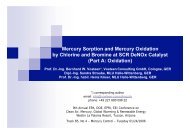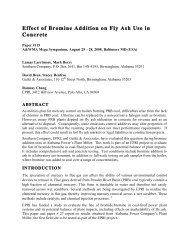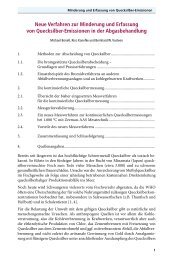08 Vosteen_E_Umbruch - Vosteen Consulting GmbH
08 Vosteen_E_Umbruch - Vosteen Consulting GmbH
08 Vosteen_E_Umbruch - Vosteen Consulting GmbH
Create successful ePaper yourself
Turn your PDF publications into a flip-book with our unique Google optimized e-Paper software.
middle part (right hand side), the kiln operator<br />
must start “slagging” the kiln’s wall.<br />
Thermographical Approach<br />
The described combined “simultaneous inner<br />
and outer thermography” as a new “non-contact<br />
wall thickness measurement” is, as far as<br />
is known to us, the first application worldwide<br />
in rotary kilns for hazardous waste incineration.<br />
Outer Temperature Measurements<br />
Outer thermographical temperature measurements<br />
are common practice in the cement industry,<br />
using so-called “line scanners”. This<br />
well-known measuring technique has been<br />
applied – since around 1989 – at some rotary<br />
kilns for hazardous waste incineration, too.<br />
Figure 5a shows an outer view at the<br />
KILN B (digital photo). As visible, the shell<br />
is partially obstructed.<br />
Figure 5b shows the corresponding outer<br />
temperature profiles (mean values as well as<br />
minimum and maximum values during one<br />
kiln rotation) as measured by a thermographical<br />
line scanner and evaluated by “RotaVos”.<br />
Inner Temperature Measurements<br />
Inner thermographical temperature measurements,<br />
using a so-called “firebox camera”,<br />
are applied in municipal solid waste incinerators<br />
for control of the burning zone location<br />
on the grates. Thermographical firebox<br />
cameras are also applied in other thermal<br />
processes (control of cement clinker cooling,<br />
of metal melting, of glass melting and glass<br />
cooling etc.).<br />
Figure 6a shows a thermographical image<br />
(BAYER-infrared-picture), made by the firebox<br />
camera M9200, looking backwards –<br />
through the post-combustion chamber – into<br />
KILN B; the thermocouple element at the<br />
kiln exit is visible even in this picture (high<br />
dissolution of the tested firebox camera).<br />
The firebox camera must apply “flame<br />
filters” to enable a clear view – through the<br />
kiln gas – directly at the slag/brick-surface,<br />
to measure the temperatures of the inner slag/<br />
brick-surface and not of the flame. Therefore,<br />
such a camera is working in a narrow wave<br />
length range of high “transmissivity of the<br />
combustion gases” (away from the CO2 and<br />
H2O radiation bands). For the same reason of<br />
visibility, dust forming wastes should be excluded<br />
from the waste feed during control<br />
measurements, minimizing gray radiation.<br />
Figure 6b shows three thermografically<br />
measured axial profiles of the inner slag surface<br />
temperature (along axial lines at the<br />
right hand, left hand and upper kiln side) in<br />
KILN A, evaluated by “RotaVos”. The lower<br />
horizontal line is indicating the<br />
gas temperature at the kiln exit, the<br />
so-called “kiln exit temperature”,<br />
given by the thermocouple element<br />
or measured thermographically<br />
along the thermocouple element’s<br />
outer surface. The thermographical<br />
temperature is almost identical<br />
(within ± 25 °C) with the thermocouple<br />
temperature itself.<br />
The excess-temperature in the<br />
kiln’s hotter middle part as marked<br />
in Figure 6b (200 °C = temperature<br />
difference between the maximal<br />
inner surface temperature and the<br />
Shell temperature in °C<br />
300<br />
250<br />
200<br />
150<br />
100<br />
50<br />
Blendings<br />
Thermography of Rotary Kilns<br />
Figure 5a. View at the outer shell of KILN B.<br />
Medium shell temperature Blending lines<br />
Max. shell temperature Environment temperature<br />
Min. shell temperature<br />
0<br />
0 1 2 3 4 5 6 7 8 9 10 11 12 13<br />
VGB PowerTech 9/2002 73<br />
Bearing ring 1<br />
Lantern post<br />
Gear ring hood<br />
Distance x from kiln entrance in m<br />
Figure 5b. Outer shell temperatures (mean values as well as minimum and maximum values<br />
during one kiln rotation) at KILN B.<br />
Figure 6a. Thermographical view back into KILN B with a PC-designed “cylindrical wire basket<br />
model of the inner kiln“ [<strong>Vosteen</strong>, 1998].<br />
Steel post<br />
Bearing ring 2<br />
Blending<br />
Blending







